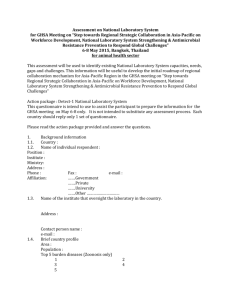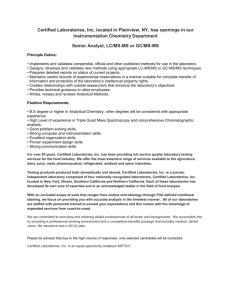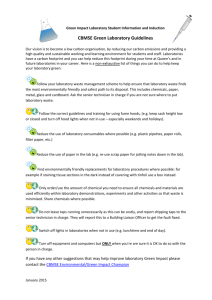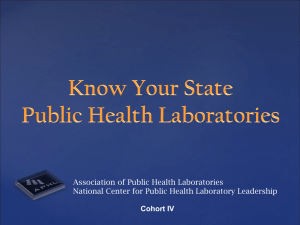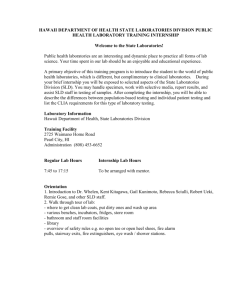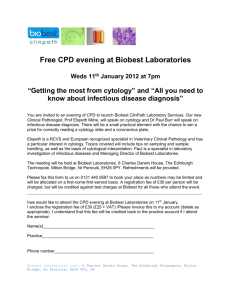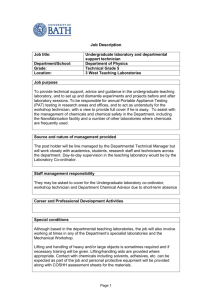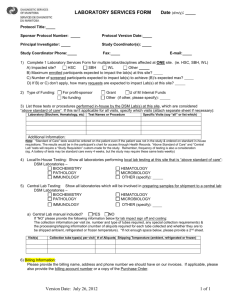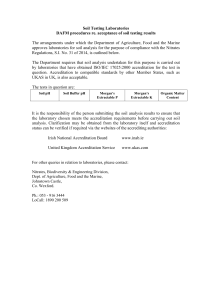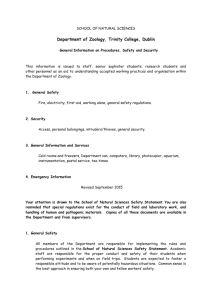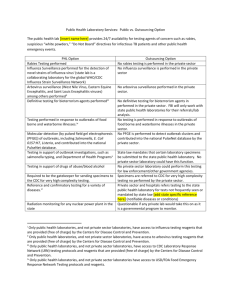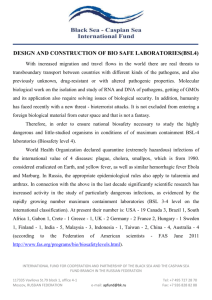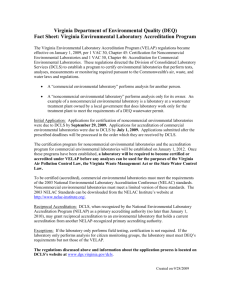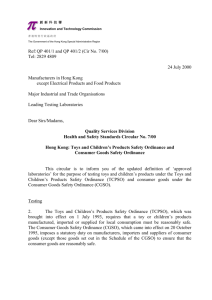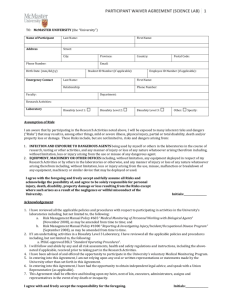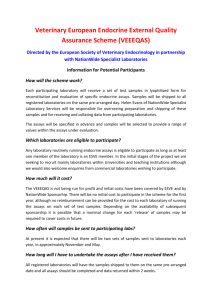Assessment on National Laboratory System for GHSA Meeting on
advertisement
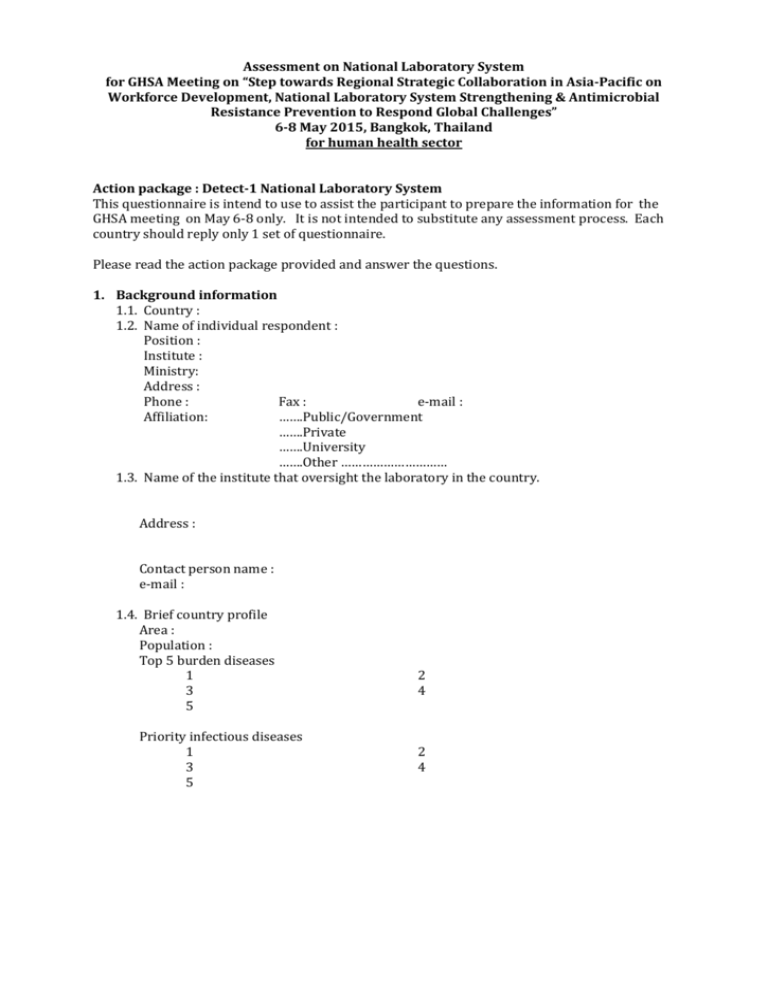
Assessment on National Laboratory System for GHSA Meeting on “Step towards Regional Strategic Collaboration in Asia-Pacific on Workforce Development, National Laboratory System Strengthening & Antimicrobial Resistance Prevention to Respond Global Challenges” 6-8 May 2015, Bangkok, Thailand for human health sector Action package : Detect-1 National Laboratory System This questionnaire is intend to use to assist the participant to prepare the information for the GHSA meeting on May 6-8 only. It is not intended to substitute any assessment process. Each country should reply only 1 set of questionnaire. Please read the action package provided and answer the questions. 1. Background information 1.1. Country : 1.2. Name of individual respondent : Position : Institute : Ministry: Address : Phone : Fax : e-mail : Affiliation: …….Public/Government …….Private …….University …….Other ………………………… 1.3. Name of the institute that oversight the laboratory in the country. Address : Contact person name : e-mail : 1.4. Brief country profile Area : Population : Top 5 burden diseases 1 3 5 Priority infectious diseases 1 3 5 2 4 2 4 2. Policy and legislation Please answer y/n and provide information concerning the questions. 2.1. Is there a national policy for health laboratory services available? …...Y/…..N If yes, please provide details on goals and objectives. 2.2. Is there a policy to ensure the quality of laboratory diagnostic capacities (e.g. licensing, accreditation, etc.)? …...Y/…..N 2.3. Are regulations, policies or strategies for laboratory biosafety/biosecurity available? …...Y/…..N 2.4. Has your country fully implemented IHR 2005? …...Y/…..N If no, what are the problems? 2.5. Does your country have a legislative framework on health laboratory? …...Y/…..N 2.6. Are national laboratory quality standards/guidelines available? …...Y/…..N 3. Laboratory capacity 3.1. Is an up-to-date and accessible inventory of public and private laboratories with relevant diagnostic capacity available? …...Y/…..N 3.2. Can the laboratory in your country perform the following tests? If yes, please choose the appropriate answers (can be more than one) and fill in the table. According to the action package, the country should be able to perform 6 core tests. The remaining four tests should be selected by the country on the basis of major national public health concerns . A. hospital lab D. research lab B. public health/ reference lab E. other (specify) Core test polymerase chain reaction (PCR) testing for Influenza virus virus culture for poliovirus serology for HIV microscopy for Mycobacterium tuberculosis rapid diagnostic testing for Plasmodium spp. bacterial culture for Salmonella Typhi 1. 2. 3. 4. 5. 6. 7. 8. 9. 10. 3.3. Have the national /reference laboratories got accreditation? …...Y/…..N 3.4. Is the BSL-3 laboratory available in your country? …...Y/…..N 3.5. Is the BSL-4 laboratory available in your country? …...Y/…..N C. national lab Y/N A B C D E(specify) 4. Networking 4.1. Are the laboratories organized in a tiered system with different levels of functions? …...Y/…..N 4.2. Does the country have specimen referral system of infectious specimen to reference laboratories? …...Y/…..N 4.3. Does your country have WHO designated reference laboratories for specific pathogens/diseases? …...Y/…..N If yes, please specify. 4.4. Does the country have the EID laboratory network? …...Y/…..N 4.5. Does the country have the collaboration between human health and animal health laboratory networks? …...Y/…..N 4.6. Does your country have access to networks of international laboratories to meet diagnostic and confirmatory laboratory requirements and support outbreak investigations for events specified in Annex 2 of IHR.2005 …...Y/…..N 5. Please rank the priority of the following activities to fit your country needs. Proposed Five-Year Action Items listed in the action package: Activities Rank The reason for the answer 1. Evaluate capacity needed at national reference, provincial, and district laboratories and implement a five-year approach based on experience with Integrated Disease Surveillance and Response (IDSR) and other ongoing platforms to build capacity at each level. 2. Integrate or increase collaboration among human and animal laboratory systems for a One Health approach. 3. Field-test novel point-of-collection diagnostics appropriate for screening outbreak specimens. 4. Train biomedical engineers in-country to certify biosafety cabinets and repair/maintain general laboratory equipment (centrifuges, fridges, freezers, incubators). 5. Systematically submit microbial samples or isolates to the public health reference laboratory/ies at the regional or national level. 6. Establish a laboratory information management system that links with the national disease reporting system. 7. Provide infrastructure improvements, security enhancements, freezers, and a pathogen access control software system to archive and protect collections of dangerous pathogens. 8. Implement step-wise improvement toward accreditation at the district and central levels. 9. Implement basic microbiology training for district-level laboratory technicians, including modules on specimen collection, packaging, transport, and disposal. 10. Identify mechanisms to integrate and sustain national and regional diagnostic capability, including acquisition of reagents and media and access 11. Others …………………………………………………. 6. Summary From the above answers, is the five-year target of the action package detect-1 achievable for your country? (…..Y/…..N) If no, please propose the suitable target for your country to achieve within five years?
